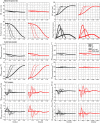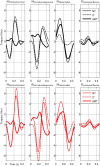Adaptive use of interaction torque during arm reaching movement from the optimal control viewpoint
- PMID: 27941920
- PMCID: PMC5151091
- DOI: 10.1038/srep38845
Adaptive use of interaction torque during arm reaching movement from the optimal control viewpoint
Abstract
The study aimed at investigating the extent to which the brain adaptively exploits or compensates interaction torque (IT) during movement control in various velocity and load conditions. Participants performed arm pointing movements toward a horizontal plane without a prescribed reach endpoint at slow, neutral and rapid speeds and with/without load attached to the forearm. Experimental results indicated that IT overall contributed to net torque (NT) to assist the movement, and that such contribution increased with limb inertia and instructed speed and led to hand trajectory variations. We interpreted these results within the (inverse) optimal control framework, assuming that the empirical arm trajectories derive from the minimization of a certain, possibly composite, cost function. Results indicated that mixing kinematic, energetic and dynamic costs was necessary to replicate the participants' adaptive behavior at both kinematic and dynamic levels. Furthermore, the larger contribution of IT to NT was associated with an overall decrease of the kinematic cost contribution and an increase of its dynamic/energetic counterparts. Altogether, these results suggest that the adaptive use of IT might be tightly linked to the optimization of a composite cost which implicitly favors more the kinematic or kinetic aspects of movement depending on load and speed.
Figures











Similar articles
-
Kinetic and kinematic adaptation to anisotropic load.Exp Brain Res. 2009 Jan;192(1):1-8. doi: 10.1007/s00221-008-1544-0. Epub 2008 Aug 26. Exp Brain Res. 2009. PMID: 18726588
-
Coordinated turn-and-reach movements. I. Anticipatory compensation for self-generated coriolis and interaction torques.J Neurophysiol. 2003 Jan;89(1):276-89. doi: 10.1152/jn.00159.2001. J Neurophysiol. 2003. PMID: 12522179
-
Immediate compensation for variations in self-generated Coriolis torques related to body dynamics and carried objects.J Neurophysiol. 2013 Sep;110(6):1370-84. doi: 10.1152/jn.00104.2012. Epub 2013 Jun 26. J Neurophysiol. 2013. PMID: 23803330 Free PMC article.
-
Evidence for a dynamic-dominance hypothesis of handedness.Exp Brain Res. 2002 Jan;142(2):241-58. doi: 10.1007/s00221-001-0913-8. Epub 2001 Nov 22. Exp Brain Res. 2002. PMID: 11807578 Free PMC article.
-
Handedness: dominant arm advantages in control of limb dynamics.J Neurophysiol. 2002 Nov;88(5):2408-21. doi: 10.1152/jn.00901.2001. J Neurophysiol. 2002. PMID: 12424282 Free PMC article. Clinical Trial.
Cited by
-
A Hybrid Framework for Understanding and Predicting Human Reaching Motions.Front Robot AI. 2018 Mar 27;5:27. doi: 10.3389/frobt.2018.00027. eCollection 2018. Front Robot AI. 2018. PMID: 33500914 Free PMC article.
-
Motor Planning of Vertical Arm Movements in Healthy Older Adults: Does Effort Minimization Persist With Aging?Front Aging Neurosci. 2020 Feb 25;12:37. doi: 10.3389/fnagi.2020.00037. eCollection 2020. Front Aging Neurosci. 2020. PMID: 32161533 Free PMC article.
-
Objective assessment of surgeon kinematics during simulated laparoscopic surgery: a preliminary evaluation of the effect of high body mass index models.Int J Comput Assist Radiol Surg. 2022 Jan;17(1):75-83. doi: 10.1007/s11548-021-02455-5. Epub 2021 Jul 24. Int J Comput Assist Radiol Surg. 2022. PMID: 34302596 Free PMC article.
-
Cerebellar Reaching Ataxia is Exacerbated by Timing Demands and Assistive Interaction Torques.bioRxiv [Preprint]. 2025 May 14:2024.10.28.620711. doi: 10.1101/2024.10.28.620711. bioRxiv. 2025. Update in: Sci Rep. 2025 Jul 1;15(1):22129. doi: 10.1038/s41598-025-03731-z. PMID: 39554081 Free PMC article. Updated. Preprint.
-
Cerebellar reaching ataxia is exacerbated by timing demands and assistive interaction torques.Sci Rep. 2025 Jul 1;15(1):22129. doi: 10.1038/s41598-025-03731-z. Sci Rep. 2025. PMID: 40592911 Free PMC article.
References
-
- Hollerbach M. J. & Flash T. Dynamic interactions between limb segments during planar arm movement. Biol Cybern 44(1), 67–77 (1982). - PubMed
Publication types
MeSH terms
LinkOut - more resources
Full Text Sources
Other Literature Sources
Research Materials

